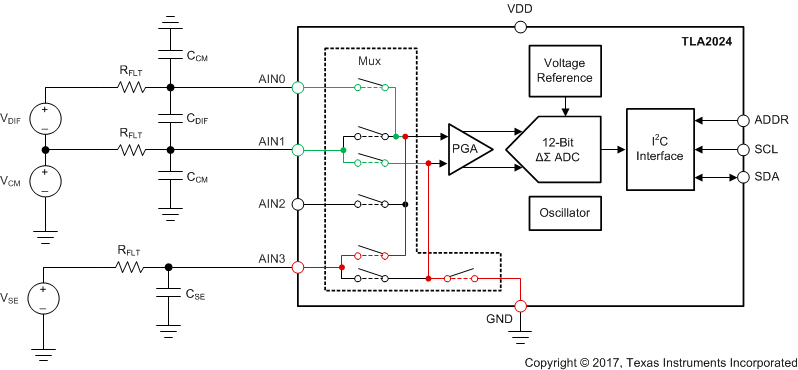ZHCSH32 November 2017 TLA2021 , TLA2022 , TLA2024
PRODUCTION DATA.
- 1 特性
- 2 应用
- 3 说明
- 4 修订历史记录
- 5 Device Comparison Table
- 6 Pin Configuration and Functions
- 7 Specifications
- 8 Detailed Description
- 9 Register Maps
- 10Application and Implementation
- 11Power Supply Recommendations
- 12Layout
- 13器件和文档支持
- 14机械、封装和可订购信息
10.1.3 Single-Ended Signal Measurements
The TLA2021 and TLA2022 can measure one single-ended signal, and the TLA2024 up to four single-ended signals. To measure single-ended signals with the TLA2021 and TLA2022, connect AIN1 to GND externally. The TLA2024 measures single-ended signals by properly configuring the MUX[2:0] bits (settings 100 to 111) in the configuration register. Figure 20 shows a single-ended connection scheme for the TLA2024 highlighted in red (a differential connection scheme is shown in green). The single-ended signal range is from 0 V up to the positive supply or +FS (whichever is lower). Negative voltages cannot be applied to these devices because the TLA202x can only accept positive voltages with respect to ground. Only the code range from 0000h to 7FF0h (or a subset thereof in case +FS > VDD) is used in this case.
 Figure 20. Filter Implementation for Single-Ended and Differential Signal Measurements
Figure 20. Filter Implementation for Single-Ended and Differential Signal Measurements
The TLA2024 also allows AIN3 to serve as a common point for measurements by appropriately setting the MUX[2:0] bits. AIN0, AIN1, and AIN2 can all be measured with respect to AIN3. In this configuration, the usable voltage and code range, respectively, is increased over the single-ended configuration because negative differential voltages are allowed when GND < V(AIN3)< VDD. Assume the following settings for example: VDD = 5 V, FSR = ±2.048 V, AINP = AIN0, and AINN = AIN3 = 2.5 V. In this case, the voltage at AIN0 can swing from V(AIN0) = 2.5 V – 2.048 V to 2.5 V + 2.048 V using the entire full-scale range.